To date, there are a large number of flowering plants that are found practically in all areas and flower beds. Such permanent flower decorations of gardens can be attributed to zinnia - bright and such diverse flowers.
Many this plant is known completely under a different name - Majors. This is a flower, without which it is simply impossible to imagine a summer garden or a summer flower garden, because this plant has just a magnificent bright look. That is why many gardeners give it a handsome preference to many exotic flowers. However, despite its fame and popularity, the cultivation of Zinnia has a number of nuances and difficulties that need to know.
In this article, we will consider the main features and description of Qinnia, as well as we note the most popular and common types and varieties of this plant. Let us open in more detail the main and important nuances of agrotechnology of growing this culture.
Features and Description Qinnia
Zinnia is a grassy or shrub perennial flowering plant, which belongs to a large astera or complex family. It was from this family that the most popular flowers in our gardens were published, such as Astra, Vityatse. Motherland Zinnia is South Mexico, where this flowering plant has spread primarily on the territory of North America, and then on the whole world. The indigenous population of America and Mexico began to cultivate Zinnia back in 1500, in Europe, this plant fell in the 18th century. In European countries, bright zinni has become loved by the aristocrats. After three centuries, Majors spread around the world, conquering the love of gardeners.
At one time, this flower was a symbol of such a US state as Indiana. The Flower of Zinnia received its name in honor of Botany and Pharmacola, Johanna Qingn, who helped the famous scientist Karl Linneu with research with his herbaric material.
An interesting fact is connected with this flower - it was Zinnia who became the first flower that bloomed in conditions of weightlessness aboard the international comic station in 2016.
Description Qinnia:
- Zinnia is a perennial plant that has decorative features. In the conditions of our climate, this flower is grown only as an annual, since his homeland is Southern Mexico with its warm climate.
- This flower is one of the most popular in the gardens around the world. The plant received the greatest popularity in North America.
- The flower of zinnia can grow in the form of a herbaceous plant or small busta, depending on the particular variety.
- On average, the height of the zinnia can be 20-100 cm.
- The stalks of this plant are quite strong, reprehension, are well reduced by windy conditions. Therefore, even tall grades do not require additional garter.
- One of the features of Zinnia is its rapid growth.
- Zinnia leaves oblong ovoid shape, slightly pointed at the top. The color is dark green, slightly pubescent. On the stems are attached without cuffs, they are sitting, there are opposite or mutton, are collected several together at the same level.
- Qinnia flowers are the top baskets that grow on long blossoms. Are single inflorescences.
- There are different in size - from 3 cm to 14 cm.
- The flower consists of tongue petals or tubular. Petal petals are located in several rows and have a different color: red, yellow, orange, pink, white. Tubular petals are located in the center of the basket and have yellow or yellowish red.
- The flowering of zinnia begins at the beginning of summer, about mid-June, and lasts to the most frosts. No wonder because this flower is called long-timing.
- The zinnia plant is distinguished by its drought resistance, but does not endure even the smallest frosts, as it is a heat-loving flower.
Most popular species and varieties of zinnia
Today, there are about 22 types of zinnia in nature, but in the conditions of our climatic belt you can grow only a few. Such plants include zinnia elegant, zinnia narrow, zinnia thin-flowered and zinnia Linaris. Consider all these species and their varieties.
Zinnia Elegant
- In culture, this type of Qinnia since 1796.
- The natural area of \u200b\u200bhabitat is a graceful area of \u200b\u200bsouthern Mexico.
- Is a herbaceous plant.
- Tall plant that can reach in a height of up to 1 meter.
- The plant is formed by reprehensive stems that are weakly branched. The entire stem is powered by hard hairs.
- The leaves of the egg-shaped plant, slightly pointed, up to 7 cm long.
- On the tops of the stems bloom by single baskets of different shades: white, orange, pink.
- Inflorescences are characterized by rather large sizes, in diameter can reach 5-16 cm.
- In the form of inflorescence, there may be simple, semi-grade and terry.
- Inflorescences consist of tongue and tubular petals.
- Flowering of elegant zinnia begins at the beginning of summer and lasts until the coldest.
- By the time of flowering: Rannets-driving, medniving, late-decreasing.
Zinnia graceful stem grades:
- Zinnia Dwarf - in height reaches only 15-30 cm. A distinctive feature of such zinc is their good branchiness and the possibility of growing both in the open ground and in pots.
- The average zinnia - height can reach 35-50 cm.
- High zinnia - plants 60-95 cm in height.
Zinnia varieties in the form of inflorescences (only 7 categories, on our territory only a few are grown):
- Zinnia Georgianoischny. Tall compact bushes, to measure branching. In the height can grow up to 90 cm. The stem thick is covered with large, up to 12 cm leaves. The inflorescences in the form of terry, semi-shaped, in diameter can reach 14 cm. Sorts of georgic color zinni: "Violet" - a plant up to 75 cm in height with inflorescences of all shades of purple; "Orange Kenig" - flowers up to 70 cm high with bright large, terry inflorescences of a red-orange shade.
- Zinnia Lilliput. It is a low compact plant up to 50 cm in height, very branching. Stems are covered with small leaves and small inflorescences. Flowers in shape resemble small pumps. Zinnia variety Lilliput: "Red Hood" - a plant up to 55 cm in height with a bright red shada "Tambelin" is a range with the colors of different shades.
- Zinnia Fantasy. Present dense compact bushes up to 60 cm in height. It features large leaves and unusual shapes with flowers, which consist of narrow, slightly twisted petals. Zinnia Fantasy varieties: "Gift" - a plant with bright red inflorescences.
In addition to these groups, the size of the elegant around the world also is also grown by the following: Zinnia California, cactius-color, supercactive, scabizo.
Zinnia narrow-leaved
- The birthplace of this type of Zinnia is South Mexico.
- It is a bush formed by reprehensive shoots that are very branched.
- Leaves small, oblong shape.
- The inflorescences of this species is also small, in shape can be simple or terry.
- Color coloring zagalized orange.
Popular varieties of zagalnya:
- Grade "Glorienesein". Dwarf plant, strongly branched in shape. Height can reach only 25 cm. It has an unusual coloring inflorescence: the very center of the petal is painted in orange tones, and at the ends - in reddish brown.
- Grade "Persian Carpet Mix". Plants that are characterized by a large number of inflorescence shades: two-color reddish shades with lemon, white, pink. Frequently used as soil plants.
Zinnia is fine color
- The average height plant that can grow up to 60 cm.
- A small bush is formed by thin and fragile stems that have an unusual reddish tint.
- On the tops of the stems there are minor inflorescences up to 3 cm in diameter.
Zinnia Linaris
- It is the lowest view of zinnia, which can reach a height of only 25-35 cm.
- The stalks of this plant thick covered with small, long and narrow leaves.
- Flowers are also small, have a yellow shade with orange border around the edge of petals.
Popular varieties of zinnia Linaris:
- Grade "Golden ah". The inflorescence of this plant variety has a white core and white tongue petals than very similar to the chamomile.
- Grade "Caramel". This plant is highlighted by inflorescences with caramel-yellow tongue petals and black tubular petals.
Reproduction of Qinnia: The most common ways
Zinnia is a flowering perennial plant, which is grown in our latitudes as annual. You can easily breed this flower self. Zinnia can multiply in two ways: seeds and seedlings. Let us consider in more detail two types of breeding of the plant.
Seed reproduction of Qinnia
It is possible to plant zinnia seeds immediately in open ground. However, this requires certain climatic conditions. If you have harsh and long winter, then seed seeds are not suitable for you in the ground. To do this, your area should have a warm and soft climate. If it is possible to make such a way:
- First of all, Zinnia seeds need to be selected. To do this, wrap them with a damp cloth and leave for a couple of days. Good seeds should germinate.
- Next, on the selected area, prepare a landing space. Carefully redo the soil and make small grooves.
- Press the seeds in them and carefully sprinkle with sand.
- From above, bedding can be covered with a film to create a small greenhouse.
- In such conditions, the seeds will germinate in about two weeks.
The reproduction of Qinny Sedoye
This method is most acceptable to our climatic conditions. Moreover, grown in the home seedlings of Zinnia is much faster to root and bloom.
- First of all, it is necessary to select only high-quality seeds. To do this, you need to moisten the gauze in Elline and wrap the seeds of Zinnia into it. In this position to hold the landing material for several days. If your seeds are fresh, they will start germinate after a couple of days. They are suitable for obtaining seedlings.
- The best time for sowing seeds to seedlings - April. If you seize them before, your seedlings can be very far from stretching out. And in the end you will get very thin and fragile plants.
- Next, you need to prepare individual pots or cups to exclude dive. Zinnia is not very like when they are disturbing in such a young age.
- The pot needs to be filled with a moisturized peat.
- Seeds are seeded by several pieces (about 2-3 pieces per one pot). From above, sprinkled with a peat about 1 cm.
- Next, the soil in the pots need to be moistened, the field of which future seedlings need to be placed in a bright and pretty warm room.
- The optimal temperature for germination of zinnia seeds 22-24 degrees of heat.
- Under such conditions, the seedlings for a few days later.
- Further care consists in regular watering.
- After some time, in about early June or at the end (for the northern regions), the seedlings obtained can be planted in an open ground.
Stages of preparation before landing Qinnia
Landing and care for the zinnius is not much difficult, but the landing process must be carefully prepared. If you have not grown on your own seedlings, it needs to be purchased. It is also important to choose on its site a suitable landing place. Consider the entire preparation process.
Stage 1. Selection of planting material
- First of all it is necessary to decide whether you will independently grow seedlings or acquire it in specialized stores.
- If you have to grow seedlings at home, then it's just following the plan described above.
- If you decide to buy a finished seedlings of Qinnia in pots, then choose specialized stores or agrofirms engaged in breeding plants to purchase.
- When buying seedlings in the store, give preference to single plants. In addition, seedlings should be strong and not too long.
- When choosing landing material, you must define a specific variety. Choose the varieties of only those zinnings that feel great in the climate conditions of your area. Do not risk, acquiring exotic species and flower varieties.
Stage 2. Selection of Places for Landing
- First of all, on its site it is necessary to choose a bright and sunny place, because zinnia is thermal-loving plants.
- The selected place should be protected from winds and drafts.
- You can choose a plot on a small hill, as Zinny prefers to grow on well-drained soils. And this means that the plant does not take close to the groundwater and stagnation of water in the roots.
- When choosing a site for landing zinnia, focus on the planning garden composition. Tall zinnia can be planted single or use for group landings. They look great along the buildings and fence. More lowered plants are suitable for disembarking on flower beds in combination with other colors. Dwarf zinnia can also be planted on the balconies in the pot or use as soil plants.
Stage 3. Choice and soil preparation for landing
- Zinnia prefers to grow on nutritional and fertile soils.
- It is also important that the soil is well drained.
- Prefer the soil with a neutral reaction.
- The selected section before planting needs to be carefully prepared. To do this, you need to move the plot to one bayonet shovel, about 40-45 cm. Thus, you remove weeds and saturate the substrate with air.
- When pumping the soil, add a deciduous humor or compost into it.
- If there is such an opportunity, you can prepare the landing site in the fall.
Landing Technology Qinnia
- It is best to engage in the planning of the seedlings of Qinnia in May, when the threat of return freezes. Zinnia does not even endure a small frost in minus 1 degree.
- Prepared from the autumn area must be slightly exploded again.
- Next, it is necessary to prepare small wells for landing zinnia.
- Zinnioms for active growth need a space, so the distance between the plants should be observed. For low-fat zinnings, it is 10-15 cm, for the average - 20 cm, for tall varieties - 20-30 cm between plants and 35-40 cm between rows.
- If you have grown seedlings yourself in peat pots, seedlings can be planted directly with them. In another case, carefully remove the seedlings without shaking the soil from the roots.
- If the selected area is located in the lowrage, it is better to provide good drainage plants. On the bottom of the wells you can pour pure river sand.
- Gently placed seedlings in the wells and sprinkle soil.
- To prevent excessive evaporation of moisture, the soil around the seedlings can be closed with a dry peat.
Growing Agrotechnics: Secrets and Nuances of Care
Qinnia does not require much care, but if you want to get lush and abundant flowering plants on your site, you need to periodically pay attention to the flower. Caring for zinnius is in periodic watering, loosening, feeding.
Watering Qinnia
Zinnia refers in plants that do not endure excessive soil moisturizing. From this, its root system can start grew and die over time. For this flower is better than the lack of moisture than excess. Watering is needed regular and moderate. It is also important to know that watering zinnia is recommended for the root, trying not to fall on the flowers. If moisture gets inside the inflorescences, they can start it.
Loosening and mulching
Periodically, the soil around the plant must be loosened, at the same time removing all weeds. It is necessary to loosen very carefully so as not to damage the stalks of the plant. Usually this process is carried out after watering to explode the soil and make it easier. To reduce the amount of loosens and reduce the number of weeds, the soil around the plants can be meditated. For it, it is recommended to use a dry peat.
Up. Zinni
For more active growth and lush flowering zinnia, it is necessary to fertilize throughout the entire growth period. The first feeders need to be done during the cultivation of seedlings (if you do this yourself). As a fertilizer during this period, mineral fertilizers must be used, while consider that the level of nitrogen fertilizers should be reduced in it.
Further zinnia feels two more times throughout the growing season. The first time the fertilizer should be carried out in 3-4 weeks after landing in the ground. As fertilizer, you can use a solution of manure or complex mineral fertilizers. The second time the plant is equipped during the formation of colors buds.
Page and trimming
Chopping zinnia is needed if you want to get a beautiful branching plant. Some begin to pinch even at the stage of growing seedlings after the appearance of the fifth leaf. However, it is quite possible to do it after landing. But if you grow zinnia for cut, especially tall varieties, it is not necessary to quote the plant.
As such pruning zinnia is not needed. However, if you delete constantly faded buds, then your plant will bloom even more abundant.
Fighting diseases and pests
Like any other plant, Zinnia is subject to the emergence of various diseases and invasion of pests.
Zinnia pests:
- Slug and snails. Such pests are best to collect with their hands. To facilitate this process, you can decompose pieces of rubberoid, which they will climb.
- May beetles. So pests are also harvested.
- Aphid. To combat this pest, it is necessary to use a mortar soap solution. If the amount of toli is significant, use special preparations, such as fuffanon.
Diseases of the plant:
- Spottedness. This disease is one of the most serious, since there is no treatment against him. If you notice signs, then affected areas need to be removed. With a large infection, the entire plant is removed.
- Gray rot. For the treatment of this disease, special drugs of fungicides are used, for example, Fundazole.
- Puffy dew. This disease is considered the most common plant for this. Manifests white spots. For its treatment, fungicides are used, for example, topaz.
Collection of Zinnia Seeds
This plant seeds ripen two months after the start of flowering. Let's deal with how to collect seeds with zinnia. Initially, select the first flavored flowers of Qinnia. After the inflorescences become brown, they need to cut and dry slightly. Next, carefully select seeds and put in a paper storage package. Zinni seeds are suitable for sowing for 4 years.
Using Zinnia in Landscape Design
- Qinnia looks great in various garden compositions. For example, these flowers can be planted on various flower beds and mix bears in the background.
- Great zinnia of tall varieties on the background of lawns and garden trees.
- You can land these plants along the economic buildings, between the beds in the garden.
- The larger varieties of zinnia can be planted along the garden tracks or the edge of the flower beds.
- As an option, they can be grown in containers and pots.
Stock Foto Zinnia in landscape design
It is more clearly to see all the features of the zinnings and the options for their placement on the site can be on the photos proposed below.
It is impossible to present a plot or flower garden without such colors as zinnia. These plants are not suitable for our conditions, while you will not need much effort in their cultivation.

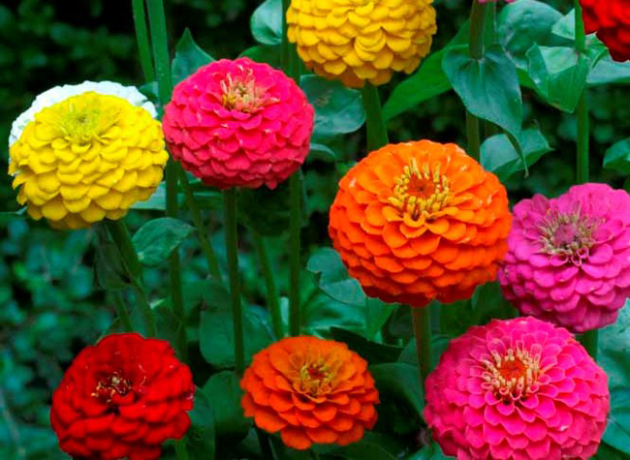
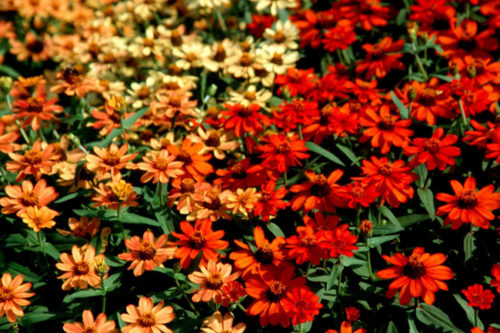
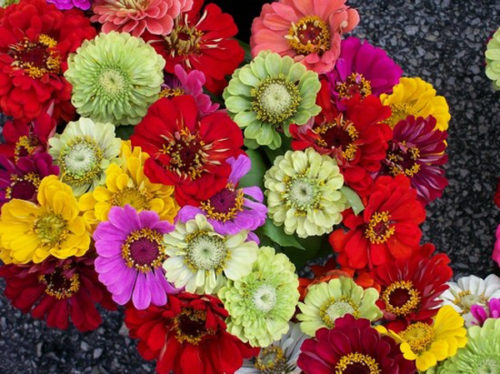

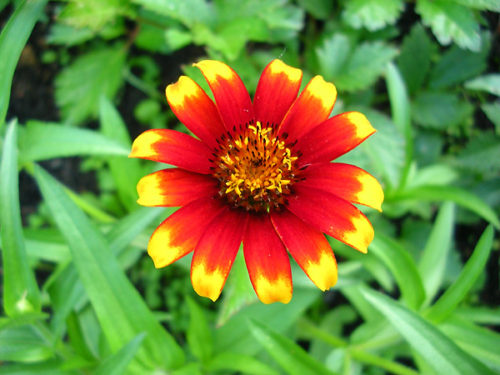
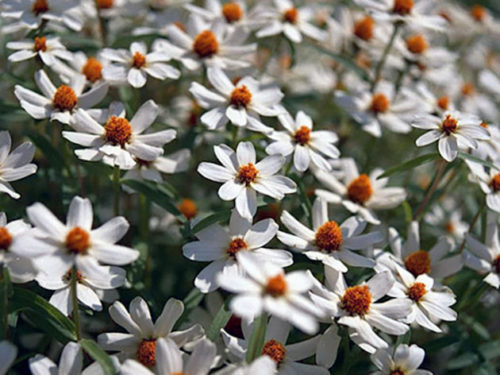
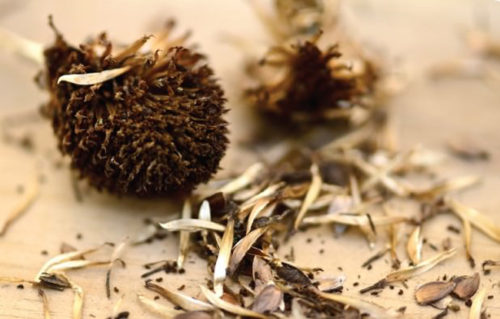
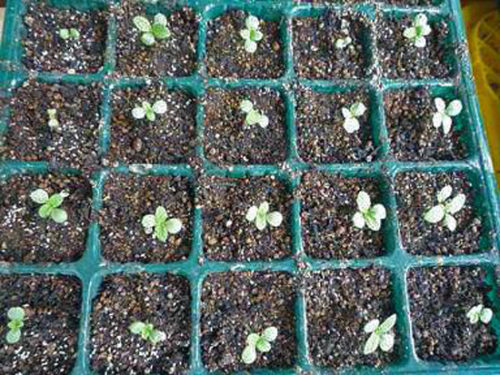
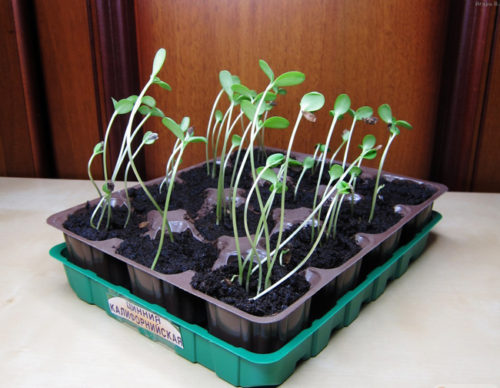
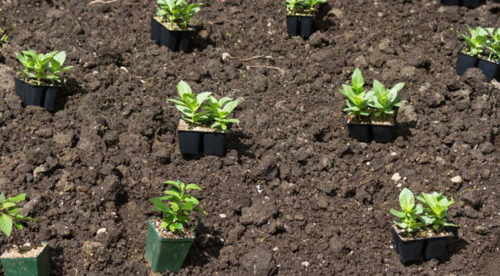
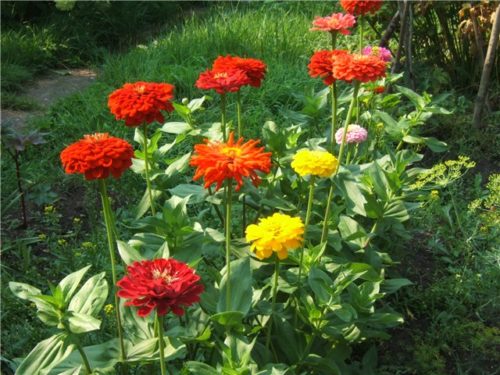
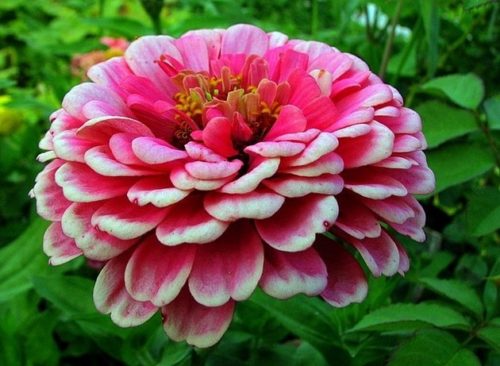
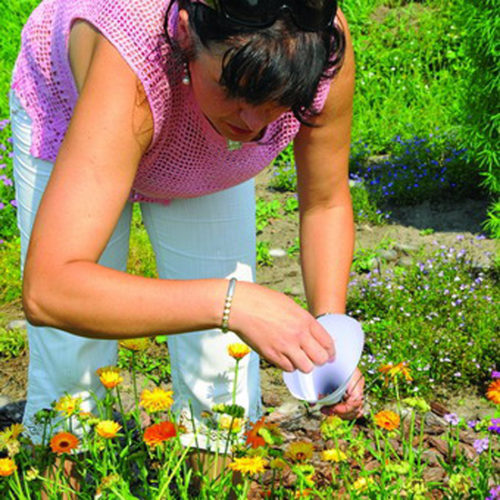
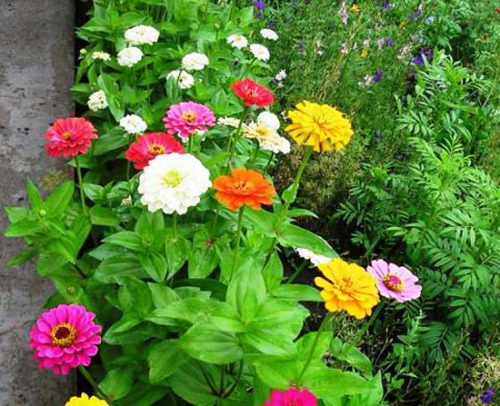
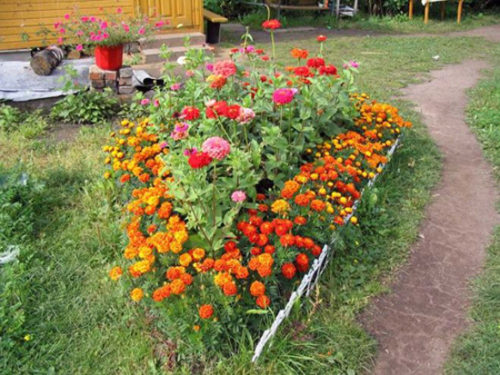
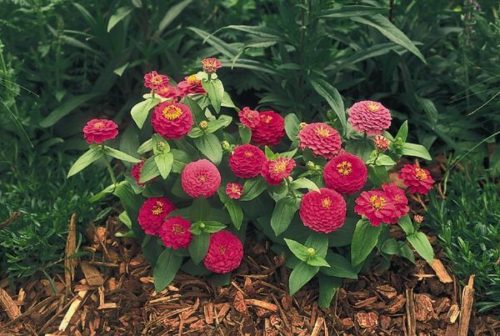
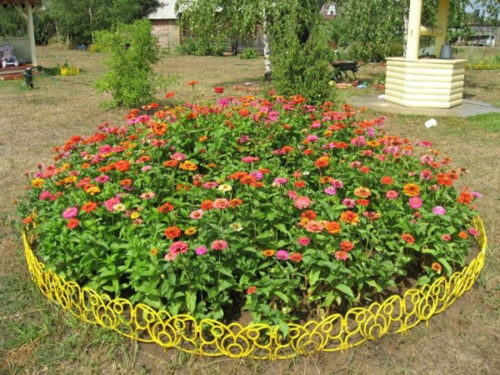












 Start a discussion ...
Start a discussion ...